Retrospective Dynamic Inundation Mapping of Hurricane Harvey Flooding in the Houston Metropolitan Area Using High-Resolution Modeling and High-Performance Computing
Abstract
:1. Introduction
2. Materials and Methods
2.1. Study Domain
2.2. Data Used
2.3. Urban Flood Model and Validation Methods
3. Results and Discussion
3.1. Spatiotemporal Evolution of Inundation
3.2. 3D image Analysis Using On-Site Photos with LiDAR-Driven Surface Model
3.3. Comparison of the Simulated Maximum Inundation Extent with Flood Maps
4. Conclusions
- High-resolution hydrodynamical modeling can provide street-resolving inundation mapping in the Houston metropolitan area with reasonable accuracy during extreme events such as Hurricane Harvey.
- The conventional flood mapping method, which assumes that inundation occurs from the overflow of rivers (i.e., fluvial flooding), is not able to capture interior inundation (i.e., pluvial flooding) caused by extreme rainfall.
- More than a half of the simulated maximum inundation extent (55%) was found outside of the conventional flood maps, only 70% of which indicated inundation during the Hurricane Harvey flooding.
- High-resolution hydrodynamic modeling can capture multi-scale inundation, ranging from site-specific flooding in residential areas to inundation by backwater from man-made reservoirs, and to inundation from overflowing rivers.
- The combination of 3D image reanalysis and LiDAR-driven ground surface modeling makes possible quantitative reconstruction of inundation extent and depth when no stage or streamflow observations exist.
Author Contributions
Funding
Acknowledgments
Conflicts of Interest
References
- van Oldenborgh, G.J.; van der Wiel, K.; Sebastian, A.; Singh, R.; Arrighi, J.; Otto, F.; Haustein, K.; Li, S.; Vecchi, G.; Cullen, H. Attribution of extreme rainfall from Hurricane Harvey, August 2017. Environ. Res. Lett. 2017, 12, 124009. [Google Scholar] [CrossRef] [Green Version]
- Emanuel, K. Assessing the present and future probability of Hurricane Harvey’s rainfall. Proc. Natl. Acad. Sci. USA 2017, 114, 12681–12684. [Google Scholar] [CrossRef] [PubMed] [Green Version]
- Blake, E.; Zelinsky, D. Tropical Cyclone Report Hurricane Harvey; National Hurricane Center, NOAA: Miami, FL, USA, 2018; p. 77.
- Jonkman, S.N.; Godfroy, M.; Sebastian, A.; Kolen, B. Brief communication: Loss of life due to Hurricane Harvey. Nat. Hazards Earth Syst. Sci. 2018, 18, 1073–1078. [Google Scholar] [CrossRef] [Green Version]
- FEMA FEMA Flood Map Service Center. Available online: https://msc.fema.gov/portal/search (accessed on 27 May 2018).
- Sarkar, S.; Singh, R.P.; Chauhan, A. Anomalous changes in meteorological parameters along the track of 2017 Hurricane Harvey. Remote Sens. Lett. 2018, 9, 487–496. [Google Scholar] [CrossRef]
- Risser, M.D.; Wehner, M.F. Attributable Human-Induced Changes in the Likelihood and Magnitude of the Observed Extreme Precipitation during Hurricane Harvey. Geophys. Res. Lett. 2017, 44, 12457–12464. [Google Scholar] [CrossRef]
- Wang, S.-Y.S.; Zhao, L.; Yoon, J.-H.; Klotzbach, P.; Gillies, R.R. Quantitative attribution of climate effects on Hurricane Harvey’s extreme rainfall in Texas. Environ. Res. Lett. 2018, 13, 054014. [Google Scholar] [CrossRef] [Green Version]
- Noh, S.J.; Lee, J.-H.; Lee, S.; Kawaike, K.; Seo, D.-J. Hyper-resolution 1D-2D urban flood modelling using LiDAR data and hybrid parallelization. Environ. Model. Softw. 2018, 103, 131–145. [Google Scholar] [CrossRef]
- Vozinaki, A.-E.K.; Morianou, G.G.; Alexakis, D.D.; Tsanis, I.K. Comparing 1D and combined 1D/2D hydraulic simulations using high-resolution topographic data: A case study of the Koiliaris basin, Greece. Hydrol. Sci. J. 2017, 62, 642–656. [Google Scholar] [CrossRef]
- Nguyen, P.; Thorstensen, A.; Sorooshian, S.; Hsu, K.; AghaKouchak, A.; Sanders, B.; Koren, V.; Cui, Z.; Smith, M. A high resolution coupled hydrologic–hydraulic model (HiResFlood-UCI) for flash flood modeling. J. Hydrol. 2016, 541, 401–420. [Google Scholar] [CrossRef]
- Mao, Y.; Ye, A.; Liu, X.; Ma, F.; Deng, X.; Zhou, Z. High-resolution simulation of the spatial pattern of water use in continental China. Hydrol. Sci. J. 2016, 61, 2626–2638. [Google Scholar] [CrossRef]
- Hartnett, M.; Nash, S. High-resolution flood modeling of urban areas using MSN_Flood. Water Sci. Eng. 2017, 10, 175–183. [Google Scholar] [CrossRef]
- Sanders, B.F.; Schubert, J.E. PRIMo: Parallel raster inundation model. Adv. Water Resour. 2019, 126, 79–95. [Google Scholar] [CrossRef]
- Liang, Q.; Du, G.; Hall, J.W.; Borthwick, A.G. Flood Inundation Modeling with an Adaptive Quadtree Grid Shallow Water Equation Solver. J. Hydraul. Eng. 2008, 134, 1603–1610. [Google Scholar] [CrossRef]
- Lewis, M.; Bates, P.; Horsburgh, K.; Neal, J.; Schumann, G. A storm surge inundation model of the northern Bay of Bengal using publicly available data. Q. J. R. Meteorol. Soc. 2013, 139, 358–369. [Google Scholar] [CrossRef] [Green Version]
- Lee, S.; Nakagawa, H.; Kawaike, K.; Zhang, H. Urban inundation simulation considering road network and building configurations. J. Flood Risk Manag. 2016, 9, 224–233. [Google Scholar] [CrossRef]
- Wang, Y.; Chen, A.S.; Fu, G.; Djordjević, S.; Zhang, C.; Savić, D.A. An integrated framework for high-resolution urban flood modelling considering multiple information sources and urban features. Environ. Model. Softw. 2018, 107, 85–95. [Google Scholar] [CrossRef]
- Noh, S.J.; Lee, S.; An, H.; Kawaike, K.; Nakagawa, H. Ensemble urban flood simulation in comparison with laboratory-scale experiments: Impact of interaction models for manhole, sewer pipe, and surface flow. Adv. Water Resour. 2016, 97, 25–37. [Google Scholar] [CrossRef]
- Pinter, N.; Santos, N.; Hui, R. Preliminary Analysis of Hurricane Harvey Flooding in Harris County, Texas. Available online: https://californiawaterblog.com/2017/09/01/preliminary-analysis-of-hurricane-harvey-flooding-in-harris-county-texas/ (accessed on 21 Mar 2019).
- UC Davis Center for Watershed Sciences Hurricane Harvey Water Extent. Available online: http://ucdsoftware.maps.arcgis.com/apps/View/index.html?appid=8350c2f309bb49f8865a44cb972024c2 (accessed on 27 May 2018).
- Wallace, T.; Watkins, D.; Park, H.; Singhvi, A.; Williams, J. How One Houston Suburb Ended Up in a Reservoir. Available online: https://www.nytimes.com/interactive/2018/03/22/us/houston-harvey-flooding-reservoir.html (accessed on 21 March 2019).
- Nelson, B.R.; Seo, D.-J.; Kim, D. Multisensor Precipitation Reanalysis. J. Hydrometeorol. 2010, 11, 666–682. [Google Scholar] [CrossRef]
- Seo, D.-J.; Breidenbach, J.P. Real-Time Correction of Spatially Nonuniform Bias in Radar Rainfall Data Using Rain Gauge Measurements. J. Hydrometeorol. 2002, 3, 93–111. [Google Scholar] [CrossRef]
- NOAA Sea Level Trends—NOAA Tides & Currents. Available online: https://tidesandcurrents.noaa.gov/sltrends/ (accessed on 21 March 2018).
- OpenStreetMap Contributors Planet Dump. Available online: https://planet.openstreetmap.org/ (accessed on 14 June 2018).
- Phillip, D.J. AP Images: Rescue Boats Fill Tidwell Road. Available online: http://www.apimages.com/metadata/Index/Harvey/32b2d5ca68f54481976beb41ab95ce74/19/0 (accessed on 4 March 2019).
- Noh, S.J.; Weerts, A.; Rakovec, O.; Lee, H.; Seo, D.-J. Assimilation of Streamflow Observations. In Handbook of Hydrometeorological Ensemble Forecasting; Duan, Q., Pappenberger, F., Thielen, J., Wood, A., Cloke, H.L., Schaake, J.C., Eds.; Springer: Berlin/Heidelberg, Germany, 2018; pp. 1–36. ISBN 978-3-642-40457-3. [Google Scholar]
- Conley, E. AP Images: A Resident in the Inundated Residential Area, Houston, Texas. Available online: http://www.apimages.com/metadata/Index/Harvey-Salud/26dfb637187a40b283dfaf2b7f0efee6/1/0 (accessed on 4 March 2019).
- Hamilton, S. Shawn Hamilton Photography on Facebook. Available online: https://www.facebook.com/pg/shawnhamiltonphotography/photos/?tab=album&album_id=1514997785252255 (accessed on 4 March 2019).
- Ciaglo, M. Harvey Houston Cars. Available online: http://www.apimages.com/metadata/Index/Harvey-Houston-Cars/3a5097f69e4b451093c3a4bc5fdb8c08/166/0 (accessed on 7 March 2019).
- DJ Willy, B. A Flooded Road on DJ Willy B’s Facebook. Available online: https://www.facebook.com/djwillyhouston/photos/p.10157231307791509/10157231307791509/?type=1&opaqueCursor=AbqdpPUgSGn_Lf3UUnifk2gBgOEMXVKHOQqvIgsYSyHL8ZpInFXglZnvvsoCV9rrxXxw1lxi_pIFbvt3S4Os1MWVWiOVNKEB-9iKgYalU-ekwR7sOJmAe84t0aUmQZvbqGW13SzcJVOSyEUSbDvyfrMFwKAnURWf1yJ0578meO0zKp6SrZdfqclR1I0ndqn8UAG-g26pqNbdOfXOhll6Ki46j4Khnan9Wem_ad_zfTa8KjLHZC6hQfTgDPKrTTtIZ6B_kzrgz2_UcLSj8ks68nrwX70LUew3YyZFIqQj1iusM0Wl5hmipiDItYDq6LJeKHED68iXI29bzfzaTjCUrdNjTdEvOqqJHnBIxxN1mmi8kZvnTrA5NbjBVdvKaqXJuhHa8p3KELQTCMLzaAS0OusPXHnCRVXg85cpF07f7g-gfA&theater (accessed on 7 March 2019).
- Mulligan, M. AP Images: Two kayakers Try to Beat the Current. Available online: http://www.apimages.com/metadata/Index/APTOPIX-Harvey/c32a2b0177444620b267e7e643f7165b/1/0 (accessed on 7 March 2019).
- Phillip, D.J. Tropical Storm Harvey: Record Rainfall, Catastrophic Flooding Hammerin|Atlanta: News, Weather and Traffic. Available online: https://www.wsbradio.com/news/local/tropical-storm-harvey-record-rainfall-catastrophic-flooding-hammering-texas/9tEYEj0kyiIrUylQxPHdQI/ (accessed on 7 March 2019).
- de Luna, M. Incredible Photos as Hurricane Harvey Hits Houston Especially Hard. Available online: http://houston.culturemap.com/news/city-life/08-27-17-photos-hurricane-harvey-hits-houston-hard/ (accessed on 7 March 2019).
- Browne, M.; Patel, J.K.; Peçanha, S.; Tiefenthäler, A.; Singhvi, A.; Williams, J. Before and After Hurricane Harvey. Available online: https://www.nytimes.com/interactive/2017/08/29/us/houston-before-and-after-hurricane-harvey.html (accessed on 21 March 2019).
- Webb, S.; Harden, J.D.; Barned-Smith, S.J.; Begley, D.; Carroll, S. Death Toll Reportedly Reaches 5 as Harvey Spawns Massive Flooding in Houston Area [Image 61]. Available online: https://www.mysanantonio.com/news/houston-texas/article/Harvey-impacts-Texas-Latest-tropical-weather-11953474.php#photo-13947846 (accessed on 7 March 2019).
- Webb, S.; Harden, J.D.; Barned-Smith, S.J.; Begley, D.; Carroll, S. Death Toll Reportedly Reaches 5 as Harvey Spawns Massive Flooding in Houston Area [Image 67]. Available online: https://www.mysanantonio.com/news/houston-texas/article/Harvey-impacts-Texas-Latest-tropical-weather-11953474.php#photo-13947684 (accessed on 7 March 2019).
- Phillip, D.J. Latest Harvey Photos: More Flooding, Water Rescues, Crowded Shelters|WTOP. Available online: https://wtop.com/media-galleries/2017/08/latest-harvey-photos-flooding-water-rescues-crowded-shelters/slide/71/ (accessed on 7 March 2019).
- Phillip, D.J. AP Images: Evacuees Wade down a Flooded Section of Interstate 610. Available online: http://www.apimages.com/metadata/Index/Harvey/a5850adc97c94433b30b6d63439b83d0/35/0 (accessed on 7 March 2019).
- Kennedy, B. In Photos: Scenes from the Heights During Harvey. Available online: https://www.houstoniamag.com/slideshows/2017/8/28/in-photos-scenes-from-the-heights-during-harvey (accessed on 7 March 2019).
- Tycksen, C. Christian Tycksen on Instagram: “Downtown Houston just Flooded all Around. @houstonchron @abc13houston @khou11 #hurricane #hurricaneharvey #houston #flood”. Available online: https://www.instagram.com/p/BYTZ6PLBuLe/ (accessed on 13 March 2019).
- Houston TranStar, TranStar Photo of I-610 (E Loop @ Market Street) on Twitter. Available online: https://pbs.twimg.com/media/DIQbfWwXoAA0PJx.jpg:large (accessed on 13 March 2019).
- Blessing, R.; Sebastian, A.; Brody, S.D. Flood Risk Delineation in the United States: How Much Loss Are We Capturing? Nat. Hazards Rev. 2017, 18, 04017002. [Google Scholar] [CrossRef]
- Brody, S.D.; Sebastian, A.; Blessing, R.; Bedient, P.B. Case study results from southeast Houston, Texas: Identifying the impacts of residential location on flood risk and loss. J. Flood Risk Manag. 2018, 11, S110–S120. [Google Scholar] [CrossRef]
- FEMA FEMA Technical References. Available online: https://www.fema.gov/media-library/assets/documents/34519# (accessed on 27 May 2018).
- Harden, J.D. Mapped: In one Houston Community, 80 percent of high-water rescue calls were outside of flood plain. Available online: https://www.houstonchronicle.com/news/houston-texas/article/In-one-Houston-neighborhood-80-percent-of-12845519.php (accessed on 21 March 2019).
- Kossin, J.P. A global slowdown of tropical-cyclone translation speed. Nature 2018, 558, 104–107. [Google Scholar] [CrossRef] [PubMed]
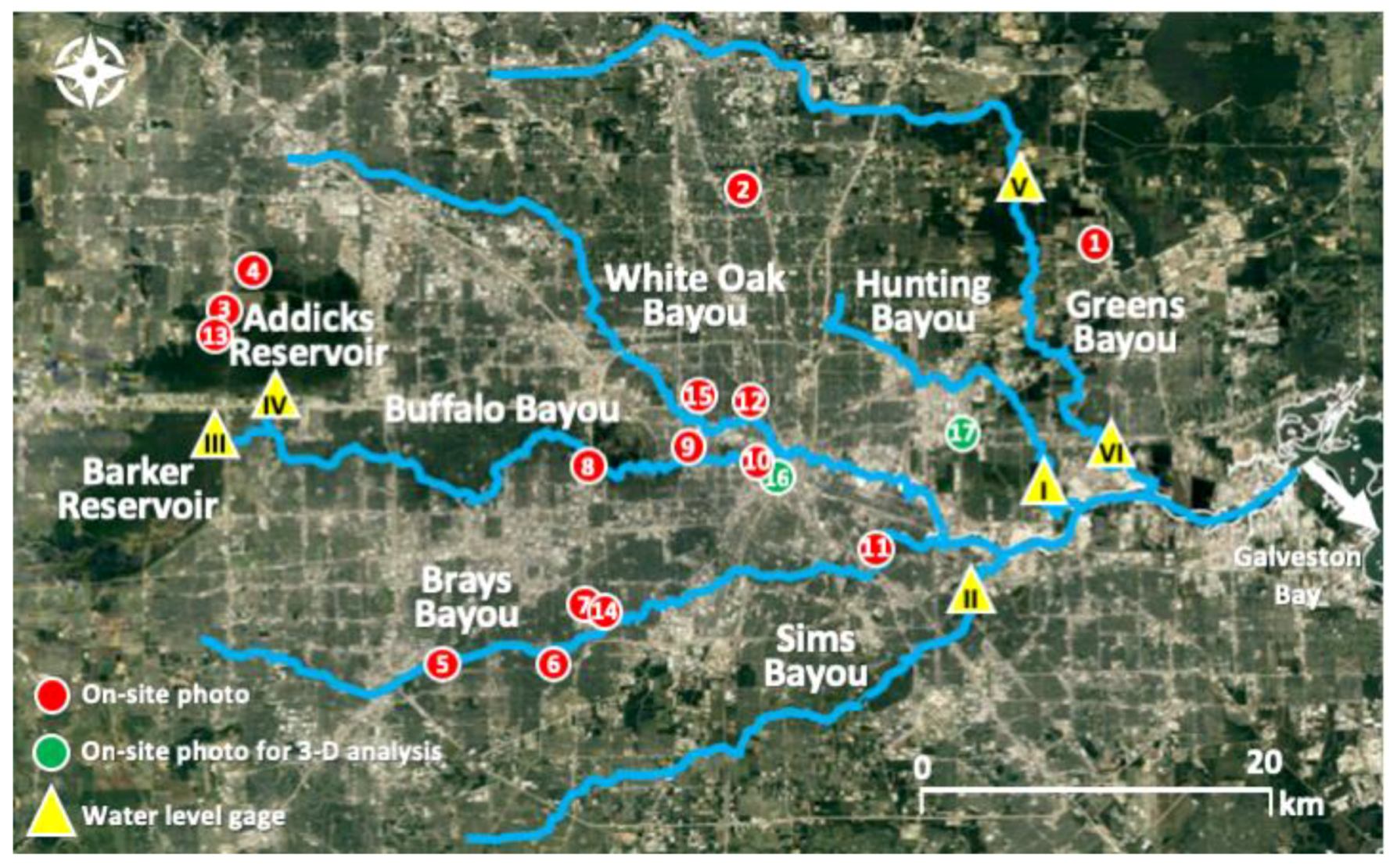



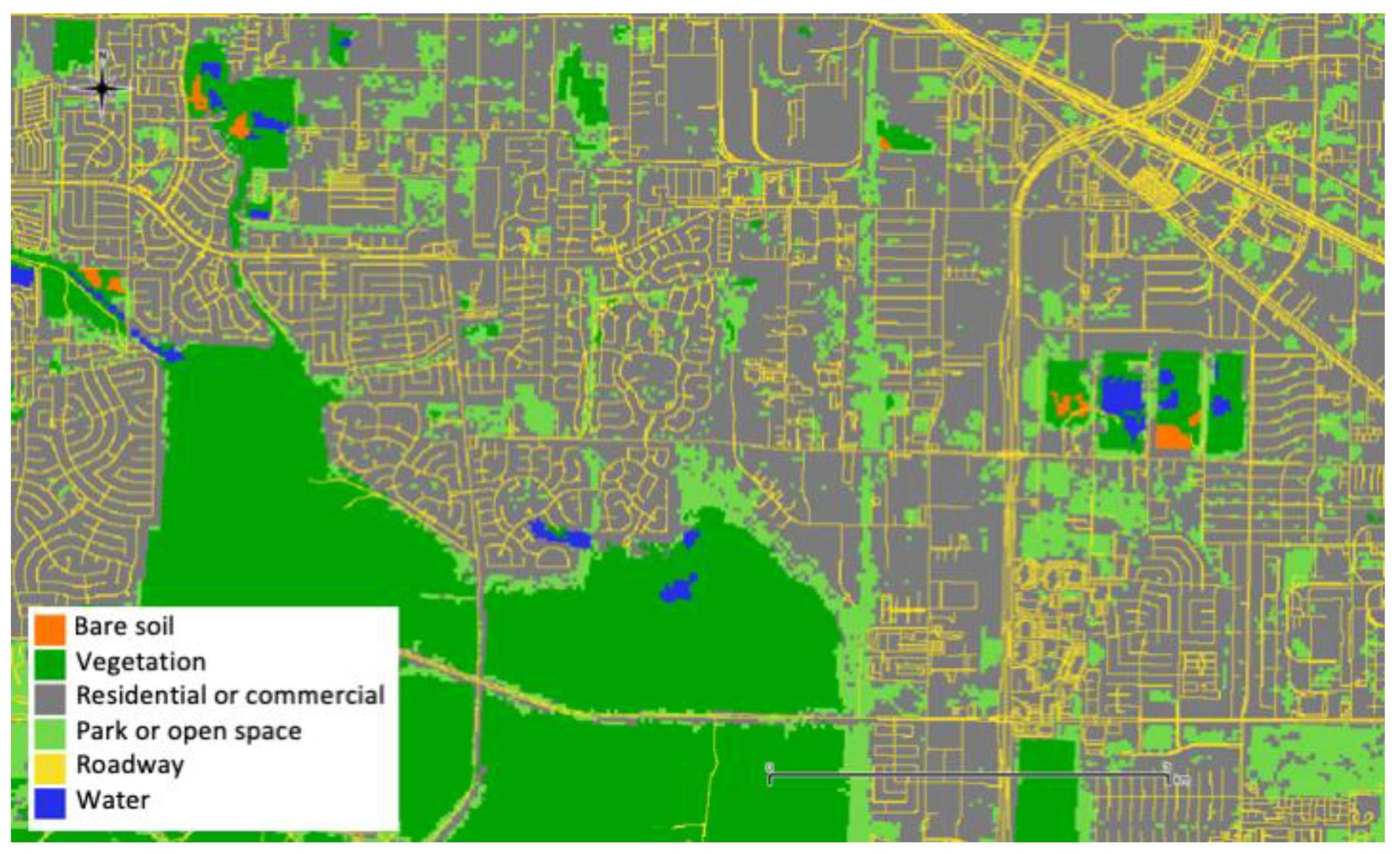



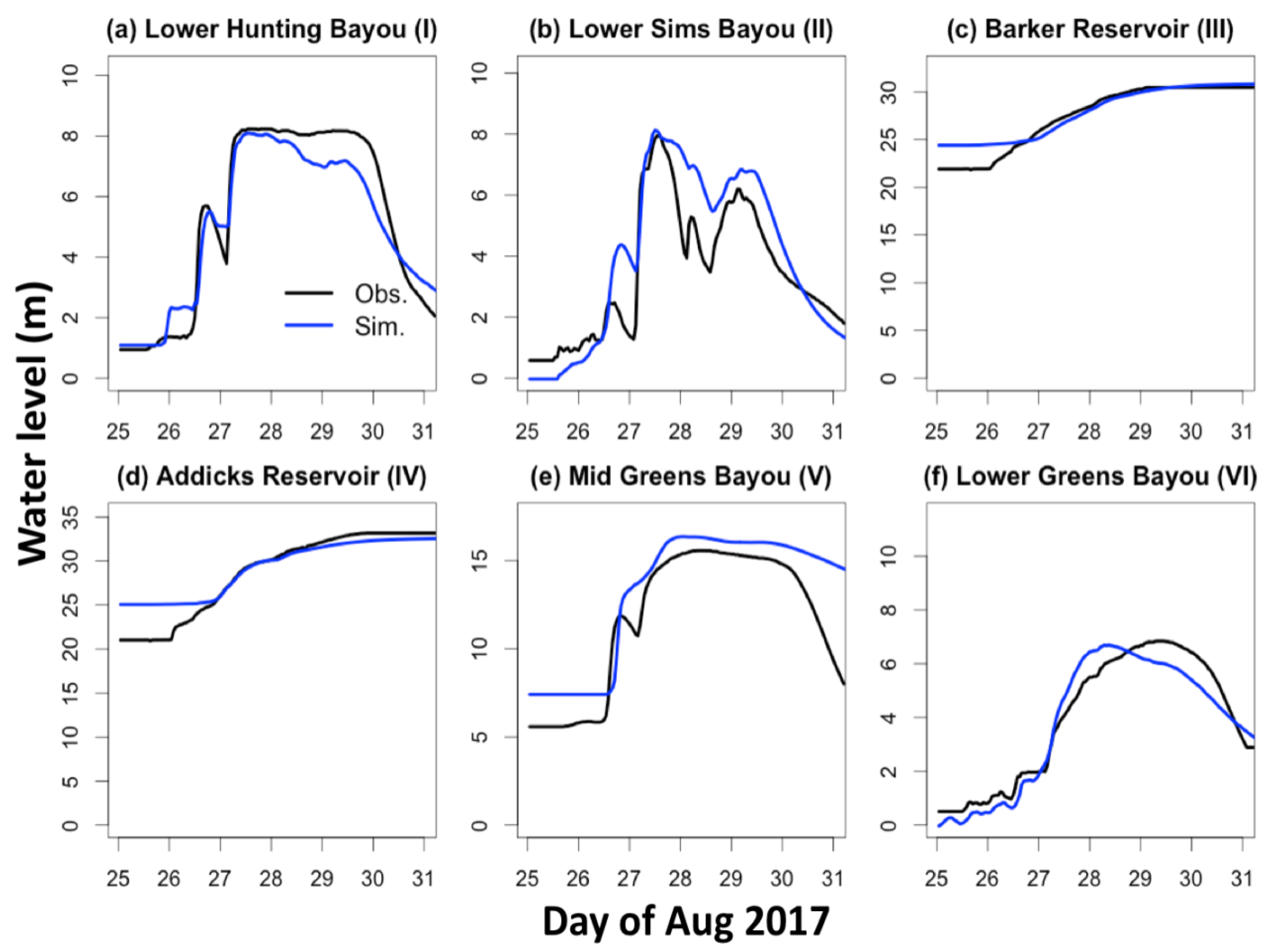
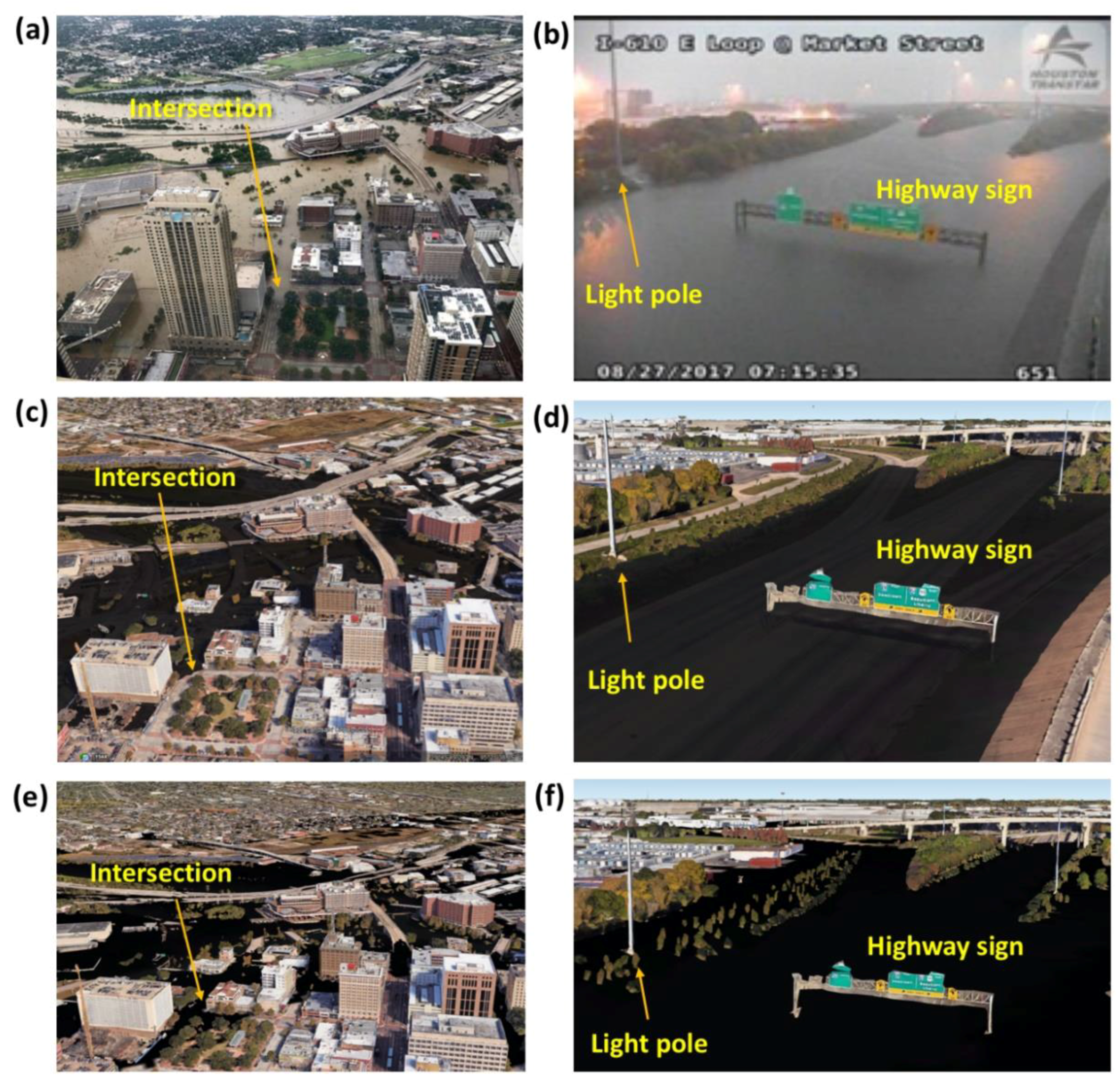
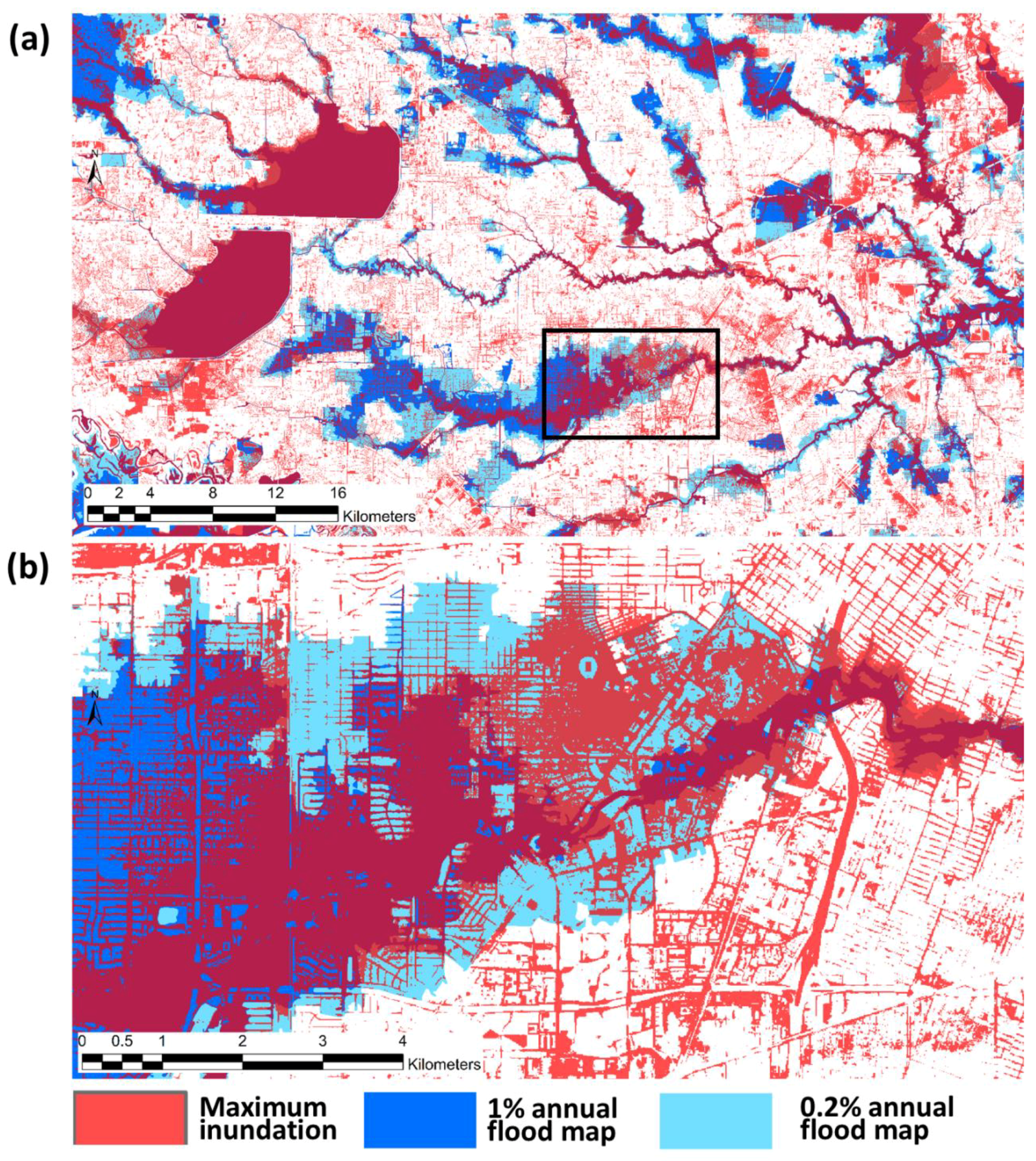
| Land Cover | Bare Ground | Vegetation | Residential or Commercial | Parking Lot or Open Space | Road | Water Body |
|---|---|---|---|---|---|---|
| Runoff coeff. | 0.6 | 0.5 | 0.9 | 0.9 | 0.9 | 1.0 |
| Manning’s roughness | 0.035 | 0.13 | 0.015 | 0.015 | 0.015 | 0.03 |
| Site No. [Reference of Photo] | Water Depth from Photos (m, A) | Simulated Water Depth (m, B) | Error Range | Time (GMT) | Location | ||
|---|---|---|---|---|---|---|---|
| Depth (m, A − B) | Percentage (A − B)/B × 100 | Latitude | Longitude | ||||
| 1 [27] | 0.5–0.7 | 0.5 | 0–0.2 | 0.0–40.0 | August 28 18:00 | 29.8532465 | −95.1923113 |
| 2 [29] | 0.4–0.6 | 0.3–0.7 | −0.3–0.3 | −100.0–100.0 | August 28 22:00 | 29.8793650 | −95.3733786 |
| 3 [30] | 0.3–0.5 | 0.4 | −0.1–0.1 | −25.0–25.0 | August 28 20:00 | 29.8319180 | −95.6456570 |
| 4 [31] | 1.0–1.2 | 1.0 | 0.0–0.2 | 0–20 | August 28 12:00 | 29.8513660 | −95.6306056 |
| 5 [32] | 0.1–0.2 | 0.2–0.4 | −0.3–0.0 | −150.0–0.0 | August 27 22:00 | 29.6714014 | −95.5283436 |
| 6 [33] | 1.5–2.0 | 1.6–2.0 | −0.5–0.4 | −31.3–25.0 | August 27 10:00 | 29.6756906 | −95.4799078 |
| 7 [34] | 0.4–0.6 | 0.6–0.8 | −0.4–0.0 | −66.7–0.0 | August 27 14:00 | 29.6846520 | −95.4588430 |
| 8 [35] | 3.0–4.0 | 3.6–5.0 | −2.0–0.4 | −55.6–11.1 | August 27 23:00 | 29.7612616 | −95.4596318 |
| 9 [36] | 0.8–1.1 | 1.1–1.6 | −0.8–0.0 | −72.7–0 | August 27 23:00 | 29.7618828 | −95.3919220 |
| 10 [36] | 0.5–1.0 | 1.5–1.7 | −1.2 to −0.5 | −80 to −29.4 | August 28 17:00 | 29.7643435 | −95.3605748 |
| 11 [37] | 2.5–3.0 | 3.0–3.2 | −0.7–0.0 | −23.3–0.0 | August 28 17:00 | 29.7098815 | −95.2547888 |
| 12 [38] | 0.9–1.1 | 1.0–1.2 | −0.3–0.1 | −30.0–10.0 | August 27 17:00 | 29.7822252 | −95.3766821 |
| 13 [39] | 0.4–0.6 | 0.4–0.6 | −0.2–0.2 | −50.0–50.0 | August 29 12:00 | 29.8394170 | −95.6454320 |
| 14 [40] | 0.5–0.6 | 0.6–0.8 | −0.3–0.0 | −50.0–0.0 | August 27 13:00 | 29.6865858 | −95.4588247 |
| 15 [41] | 0.6–0.7 | 1.0–1.4 | −0.8 to −0.3 | −80.0 to −21.4 | August 28 19:00 | 29.8055937 | −95.4280031 |
| Site No. | Gaging Location | RMSE (m) | NSE |
|---|---|---|---|
| Average | - | 1.25 | 0.84 |
| I | Lower Hunting Bayou | 0.78 | 0.93 |
| II | Lower Sims Bayou | 1.21 | 0.68 |
| III | Barker Reservoir | 1.18 | 0.88 |
| IV | Addicks Reservoir | 1.86 | 0.84 |
| V | Mid Greens Bayou | 0.64 | 0.92 |
| VI | Low Greens Bayou | 1.79 | 0.79 |
| Simulated Maximum Inundation Extent (km2) | FEMA Flood Maps (km2) | |||
|---|---|---|---|---|
| Total | Inundation within FEMA Maps | Inundation Outside of FEMA Maps | 0.2% Flood Map | 1% Flood Map |
| 1404.6 (100%) | 636.6 (45%) | 768.0 (55%) | 915.0 | 594.1 |
© 2019 by the authors. Licensee MDPI, Basel, Switzerland. This article is an open access article distributed under the terms and conditions of the Creative Commons Attribution (CC BY) license (http://creativecommons.org/licenses/by/4.0/).
Share and Cite
Noh, S.J.; Lee, J.-H.; Lee, S.; Seo, D.-J. Retrospective Dynamic Inundation Mapping of Hurricane Harvey Flooding in the Houston Metropolitan Area Using High-Resolution Modeling and High-Performance Computing. Water 2019, 11, 597. https://doi.org/10.3390/w11030597
Noh SJ, Lee J-H, Lee S, Seo D-J. Retrospective Dynamic Inundation Mapping of Hurricane Harvey Flooding in the Houston Metropolitan Area Using High-Resolution Modeling and High-Performance Computing. Water. 2019; 11(3):597. https://doi.org/10.3390/w11030597
Chicago/Turabian StyleNoh, Seong Jin, Jun-Hak Lee, Seungsoo Lee, and Dong-Jun Seo. 2019. "Retrospective Dynamic Inundation Mapping of Hurricane Harvey Flooding in the Houston Metropolitan Area Using High-Resolution Modeling and High-Performance Computing" Water 11, no. 3: 597. https://doi.org/10.3390/w11030597
APA StyleNoh, S. J., Lee, J.-H., Lee, S., & Seo, D.-J. (2019). Retrospective Dynamic Inundation Mapping of Hurricane Harvey Flooding in the Houston Metropolitan Area Using High-Resolution Modeling and High-Performance Computing. Water, 11(3), 597. https://doi.org/10.3390/w11030597






